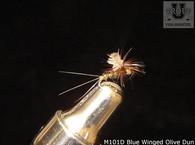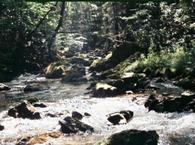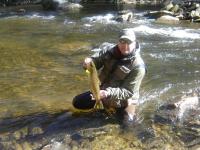
This course will outline for the student how to approach the stream, the importance of stealth, and how to do the basic presentation of the lure, then set the hook.
Generally, it is advisable to walk and cast upstream while fishing. This prevents the fish from seeing you as you approach. Also, keep a low profile and stay out of the water (especially still water) as much as possible. As you approach a pool from downstream, cast first to the tail end of the pool right where the water begins to accelerate as it leaves the pool. 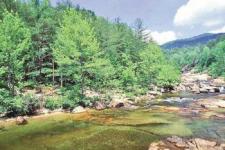
Remember to keep the line tight by reeling in the excess line, and do not let there be any noticeable slack in the line. This will enable you to feel the slight tug as a trout takes the bait. Sometimes, you will see the line moving in a manner that obviously in not as a result of the current, and this is an indication that the trout has gingerly sucked in the bait.
Often times, there is a trout (most commonly a brown or brook trout) hanging out in this area, and otherwise you may scare it before you even know it’s there. However, there are times when fishing upstream is not an option. When this occurs, it is possible to cast downstream. 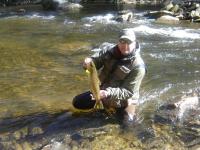
Next, cast to the still water off to the sides of the pool, if applicable. Then, cast toward the head of the pool, in the vicinity of the swift water entering the pool. Finally, don’t overlook small “tidal pools”, pocket water (non-pooling water), downed trees, and crevices under rocks as hiding places for trout (especially brown trout).
When using fly line in a stream, try to keep as much of the line out of the water as possible, to avoid the effects of drag on the line. For example, if your fly lands in still water, and your fly line lands in fast water, the line will be moving faster than the fly to the extent that it will eventually pull the fly through the still water.

When trout fishing in a lake, beaware of the most important areas which are the inlet, the outlet, streams dumping into the lake and the underwater springs. All have an impact on the flow of food being delivered to the feeding trout as well as the temperature. Generally, springs and water flowing into the lake will be cooler and moving. Therefore, that water will be more oxygenated have a positive effect on the feeding habits of the trout.
Sunlight will be a factor as it contributes to the growth of trout food. Watch for overhanging branches tha allow terrestrials to fall into the water, as these will be more productive areas. Do not overlook lakes caused by the dams that are used for generating electricity. These lakes usually are deep and the water can be drawn off the bottom (tailwaters). Therefore, the water will be cooler and support trout in areas where it normally would be too hot for the trout to exist. Watch the most popular DVD about tailwater fishing for trout.
Once a fish strikes, set the hook by quickly pulling up on the fishing rod. This will drive the hook into the fish’s mouth. Be careful not to pull too hard when a small fish strikes, or you can damage the fins.
2.) How to Cast: Fly Fishing Tips for Beginners
3.) The student is now ready to attend the more advanced classes.
Recommended DVDs:
Fishing Strategies That Catch Fish
Geting Started Fly Fishing Basics
Also please check the list of Fly Fishing Instructional DVDs for specific species and conditions.
Recommended Reading:
Trout Unlimited's Guide to America's 100 Best Trout Streams
These are the rivers that anglers dream of visiting. Describing species, hatches, the flies and lures, and when to fish, each profile contains information and maps that boosts angler success.



